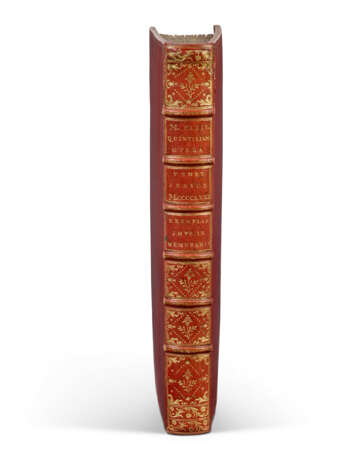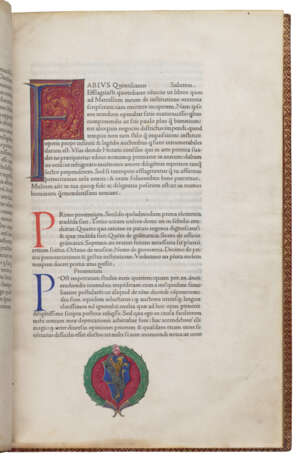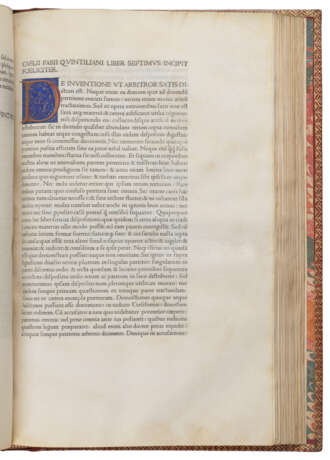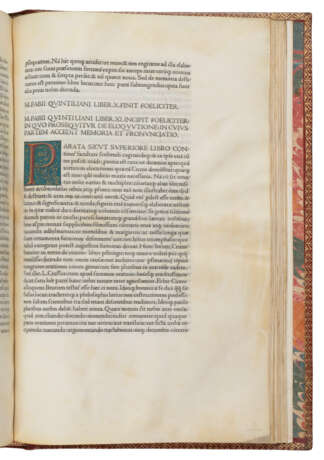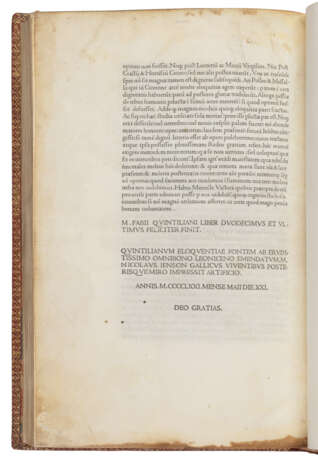ID 794460
Lot 116 | QUINTILIANUS, Marcus Fabius (c. 35-95)
Estimate value
£ 220 000 – 320 000
Institutiones oratoriae. Edited by Omnibonus Leonicenus (d.1493). [Venice:] Nicolaus Jenson, 21 May 1471.
Deluxe copy, one of only three printed on vellum, illuminated by the Putti Master; with distinguished, bibliophile provenance from the Gaignat, La Vallière, MacCarthy-Reagh, Hibbert, and Devonshire collections. It is finely illuminated by the Putti Master, a miniaturist active at Venice c.1466 to 1475, who executed a number of important commissions for early Venetian printers, particularly Jenson. The initials here are characteristic of his work: 3-dimensional letters, called littera mantiniana, in gold on a dark coloured ground. Although the arms of the contemporary owner have not been identified (Van Praet's ascription to the Soranzo family is patently wrong), the luxury of the vellum copy and its rich illumination indicate a wealthy and influential patron. (Cf. Armstrong, Renaissance Miniature Painters and Classical Imagery, 1981, where this is no. 10.)
It is the third edition, the first edited by humanist Leoniceno, of Quintilian's pedagogical treatise on classical rhetoric covers not only the training of an orator but also general educational theory, ancient literary criticism and the technicalities of rhetoric. Nearly forgotten during the Middle Ages, the Institutiones oratoriae was rediscovered during the Renaissance and exerted a strong influence on Renaissance and later prose style and literary criticism.
The 1471 Quintilian is printed with Jenson's justly famous Roman type, considered by Bruce Rogers as the most perfect: [with it] 'the roman letter was done once, perfectly, for all time.' Based on the excellence of his texts and type, Jenson was created Count Palatine by Pope Sixtus IV by 1475. In his address to the Bishop of Belluno, Leoniceno – undoubtedly with the tacit approval of Jenson – refers to Jenson as the inventor of printing: 'qui librariae artis mirabilis inventor: non ut scribantus calamo libri: sed veluti gemma imprimantur.' A large copy, significantly taller than the British Library copies. The other two vellum copies are both at the Bibliothèque nationale at Paris. HC *13647; BMC V, 168; CIBN Q-16; BSB-Ink. Q-13; Bod-Inc. Q-013; Van Praet, Vélins du roi, IV, 25-26; Goff Q-26; ISTC iq00026000.
Printed on vellum. Median folio (349 x 230mm). 211 leaves (of 212, without final blank). Illuminated in camaieu d’or by the Putti Master, 8-line initial opening text in gold and blue on magenta ground historiated with a reclining putto, an eagle, and a crane, 11 similar 6-line initials opening each subsequent book in blue or red on purple, green, blue or lavender ground, 2- to 5-line initials alternating in red or blue, spaces for Greek, a few ms. guide-letters and quiring visible. Pinholes at outer corners. (Initial to book 3 very rubbed, a few small wormholes in first and final quires, stain at extreme margins of first 2 leaves.) 18th-century French red morocco, triple fillet border to sides, spine gilt and lettered, gilt turn-ins, marbled endpapers, gilt edges (head of spine neatly repaired, very minor wear at hinges); modern red morocco folding box, spine lettered in gilt. Provenance: unidentified arms on first text page: lion d'or sur azure, overall on a bend argent an ivy vine proper (mistakenly identified by Van Praet as the Soranzo family of Venice) – Louis Jean Gaignat (1697-1768, sale Paris, 10 April 1769, lot 1506, 491.4FFr) – Louis César de la Baume, duc de La Vallière (1708-1780, sale Paris 1783, lot 2334, 500 FFr) – Count Justin MacCarthy-Reagh (1744-1811, sale Paris, 1817, lot 2263, 1,515 FFr) – George Hibbert (1757-1837, sale Evans, 16 March 1829, lot 6741, £71.15 to Payne) – William Cavendish, 6th Duke of Devonshire (1790-1858, Chatsworth bookplate, Chatsworth Catalogue, 1879, III, 274, sale Christie's, 6 June 1974, lot 16, £26,000) – Haven O'More (booklabel, sale Sotheby's, New York, 9 November 1989, lot 9) – [sale Christie’s, 29 November 2000, lot 29].
Special notice
No VAT on hammer price or buyer's premium.
| Place of origin: | Italy, Europe |
|---|---|
| Auction house category: | Antiquarian books, Printed books |
| Place of origin: | Italy, Europe |
|---|---|
| Auction house category: | Antiquarian books, Printed books |
| Address of auction |
CHRISTIE'S 8 King Street, St. James's SW1Y 6QT London United Kingdom | |
|---|---|---|
| Preview |
| |
| Phone | +44 (0)20 7839 9060 | |
| Buyer Premium | see on Website | |
| Conditions of purchase | Conditions of purchase |
